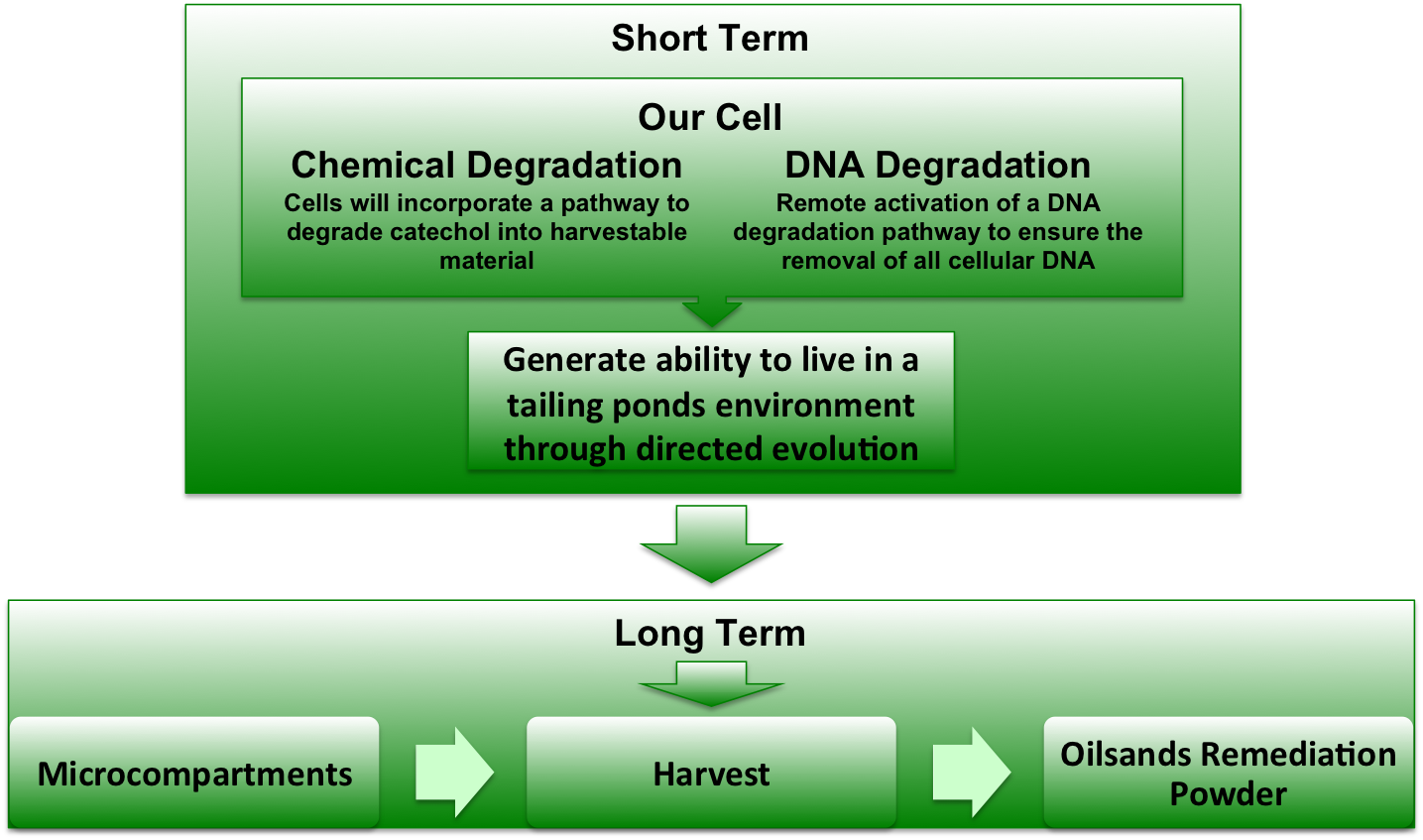Team:Lethbridge/Project
From 2010.igem.org
Liszabruder (Talk | contribs) |
Liszabruder (Talk | contribs) |
||
| Line 137: | Line 137: | ||
=<font color="white">Project Abstract= | =<font color="white">Project Abstract= | ||
| - | The emerging field of synthetic biology is the combination of engineering approaches with state-of-the-art molecular and cellular biology techniques. It has the potential to change almost every industry. The International Genetically Engineered Machines (iGEM) competition allows undergraduates from diverse backgrounds to explore research in synthetic biology. The University of Lethbridge 2010 iGEM team has created a synthetic-biology-based approach for bioremediation of the tailings ponds. The industrial methods, used to harvest the oil sands, produce contaminated water in the form of tailings ponds that contain many harmful chemicals such as naphthalic acids, catechol and heavy metals. We are targeting catechol for degradation into common metabolic intermediates of the Krebs Cycle by using <i>xylE</i> from <i>Pseudomonas putida</i> that codes for the protein catechol-2,3-dioxygenase. Catechol-2,3-dioxygenase is being targeted into microcompartments, formed from an engineered <i>Aquifex aeolicus</i> protein, lumazine synthase, to reduce cross-talk and increase concentration. This complex can then be purified and applied to the tailings for catechol degradation. By funnelling other pathways through catechol we can develop efficient methods for the decontamination of the tailings ponds. <i>Mms6</i> from <i>Magnetospirillum magneticum</i> has been shown to remove heavy metals from solution. The Mms6 protein will be engineered for secretion from the cell into the tailings for the formation of nanoparticles such as iron and cobalt. Removal of the heavy metals found within the tailing will aid in creating an efficient bioremediation process. | + | The emerging field of synthetic biology is the combination of engineering approaches with state-of-the-art molecular and cellular biology techniques. It has the potential to change almost every industry. The International Genetically Engineered Machines (iGEM) competition allows undergraduates from diverse backgrounds to explore research in synthetic biology. The University of Lethbridge 2010 iGEM team has created a synthetic-biology-based approach for bioremediation of the tailings ponds. The industrial methods, used to harvest the oil sands, produce contaminated water in the form of tailings ponds that contain many harmful chemicals such as naphthalic acids, catechol and heavy metals. We are targeting catechol for degradation into common metabolic intermediates of the Krebs Cycle by using <i>xylE</i> from <i>Pseudomonas putida</i> that codes for the protein <html><a href="https://2010.igem.org/Team:Lethbridge/Project/Catechol_Degradation"><font color="green"> catechol-2,3-dioxygenase</font></a></html>. Catechol-2,3-dioxygenase is being targeted into <html><a href="https://2010.igem.org/Team:Lethbridge/Project/Compartamentalization"><font color="green"> microcompartments</font></a></html>, formed from an engineered <i>Aquifex aeolicus</i> protein, lumazine synthase, to reduce cross-talk and increase concentration. This complex can then be purified and applied to the tailings for catechol degradation. By funnelling other pathways through catechol we can develop efficient methods for the decontamination of the tailings ponds. <html><a href="https://2010.igem.org/Team:Lethbridge/Project/Magnetic_Nanoparticles"><font color="green"> <i>Mms6</i></font></a></html> from <i>Magnetospirillum magneticum</i> has been shown to remove heavy metals from solution. The <i>Mms6</i> protein will be engineered for secretion from the cell into the tailings for the formation of nanoparticles such as iron and cobalt. Removal of the heavy metals found within the tailing will aid in creating an efficient bioremediation process. |
=<font color="white">Oil Sands Initiative Project Proposal= | =<font color="white">Oil Sands Initiative Project Proposal= | ||
 "
"














